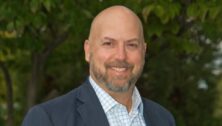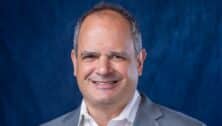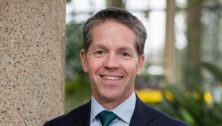Chester County Leadership: Martha Sharkey, Executive Director, TODAY is a Good Day
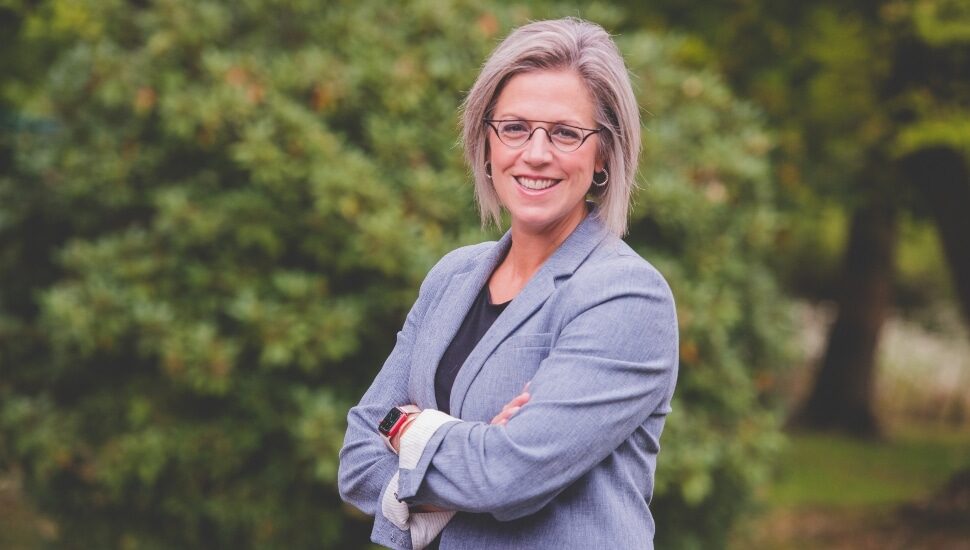
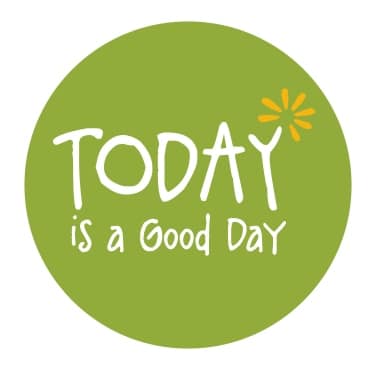
Flourtown resident Martha Sharkey, Founder & CEO of TODAY is a Good Day, spoke to VISTA Today about growing up in Lancaster County near farmland, her first job at a museum store that she continued into adulthood, and why she chose to go to Penn State despite her initial reluctance.
Sharkey, whose career centered around nonprofits and fundraising, discussed why she and her husband founded TODAY is a Good Day, which provides personal and financial support for families who experience the Neonatal Intensive Care Unit (NICU). She shared her family’s experience with the NICU and why she believes hope is something that evolves and changes.
Where were you born, and where did you grow up?
I grew up on the east side of Lancaster City near Dutch Wonderland and the outlets in Lancaster County.
What did your parents do?
My mother taught at McCaskey High School in the City of Lancaster for over 35 years. My dad is an industrial engineer, and he worked at Dart Container. He can fix anything that needs to be fixed.
Where were you in the pecking order?
I have one brother who is four and a half years older than me. We’re very close. He and his family settled about two miles from us in the Glenside area, right behind my mother-in-law, so my parents can see both of us when they come in from Lancaster.
What do you remember most about growing up in Lancaster?
I had a great childhood. I had cows in my backyard, and we used to snowmobile through the fields. We had beautiful farmland around us and a great neighborhood growing up – lots of kick-the-can in the backyard and playing basketball. I remember bike rides on the country roads. My brother and I had an Amish babysitter when I was young, who we are both still friends with today.
What kind of jobs did you have growing up?
I was very blessed as a child. My aunt started a museum store at the Heritage Center of Lancaster County when I was about 11 years old to help raise revenue for the museum. She had a whole team of volunteers. When I was 11 years old, I volunteered with my mom, grandmother, and aunt in her store.
When I was 16, I became the store’s first paid employee. I worked there all through high school and college. I actually came back after Penn State and took over for my aunt as the store manager and buyer.
What lessons did you take from working in your aunt’s store that stay with you today?
My aunt trained me from an early age. She taught me about pricing, buying, and all those different lessons. But the biggest lesson I learned was working with the incredible volunteers who dedicated much of their time to the museum store.
It helped direct the path I took in life. Learning about fundraisers, how the museum operated, and how to manage and work with volunteers – making sure they felt valued for what they gave the organization.
What about sports? Did you play any sports growing up?
I did, but not well. I played tennis, a little field hockey early on, and soccer. I was big into plays and musicals. I was also in the marching band. I played the xylophoneand was drum major later in high school.
What kind of music floated your boat in high school and college?
We listened to a lot of Country in our house. I loved country music and still do. That influence came from my dad, who grew up in West Virginia.
Did you have a favorite artist?
Well, Dolly Parton is up there. And I love some of the newer Country, like Eric Church, Lainey Wilson, and Ashley McBryde.
Did you go to concerts when you were growing up?
I went to a few. My first concert, I still remember, was at Hershey Park. I was in high school, and I went to see Alanis Morissette.
You were a pretty good student. Why did you decide to go to Penn State?
I did not want to go to Penn State. My mother had said, “You need to go to Penn State. You need something to do 24 hours a day, and Penn State will be perfect for you.”
I told her, “I’m not going to Penn State.” She sent me up to visit a dear friend of mine, Tim, who was a year ahead of me and had gone to Penn State. I came home, and, as per usual, I said, “Well, you’re right.”
What was it about your weekend at Penn State that captured you?
The life and the community. Penn State still makes me smile every time I talk about it.
People are usually lost their first year at Penn State – it’s such a big place. Did that happen to you?
It did not happen to me, but I always tell kids thinking about going to Penn State that it’s all about finding your activity. Penn State is big if you want it to be big, but it’s not if you find the activity that works for you. I joined Kappa Delta Sorority my freshman year, which helped shape who I would become later in life.
You found yourself at Penn State?
I made some of my best friends for life. I met my wonderful husband at Penn State during our senior year. And the leadership opportunities through my sorority – becoming a part of the Leadership Council my sophomore year as vice president of standards and then moving into the president’s role.
Then I moved on to being a part of the Pan-Hellenic Council in charge of recruitment. All of those experiences shaped my Penn State career. And the networking – just the friendships and connections made, not only with students, but our Greek adviser is a lifetime friend of mine.
Looking back over your career, Martha, who were the people who saw promise in you?
When I returned to Lancaster, I had several great opportunities through the Heritage Center to become involved in the downtown. Also, the museum director at the time, Peter Seibert, trusted me enough to give me opportunities to be engaged in fundraising and engage the folk artists that were a part of the museum store.
What did Peter see in you?
I think Peter saw leadership and the ability to connect with people and network. That’s an area that is so important and that I really enjoy.
Where does that come from?
I don’t know – I think part of that’s just ingrained in who you are and how you’re raised. My husband and I always say that we love meeting new people, so our favorite thing is to network and make new connections.
How did ‘Today is a Good Day’ come into existence?
Life takes you on a path that leads you in the direction you’re supposed to go. I look back at always being a part of the nonprofit world, fundraising and boards, and all the different life experiences I’ve been blessed to have in the past 20 years. Todayis a Good Day truly came from our life experiences.
My husband and I found out that we were expecting in July 2010 when I was working at the Franklin Institute. We soon found out that we were expecting identical twin girls. Our daughters were due in March of 2011, and they arrived over four months early, in November 2010.
The NICU experience at Jefferson Abington Hospital was transformative for our family. We knew nothing about the Neonatal Intensive Care Unit experience.
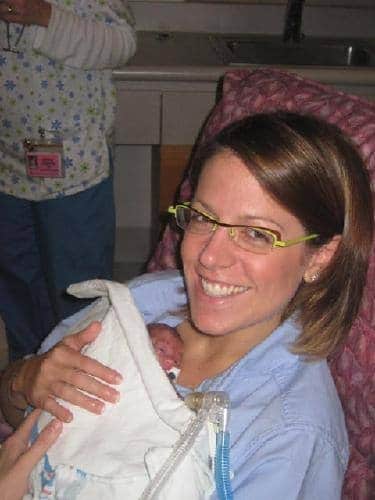
Claire was born 1 pound 2 ounces at birth, and Mary was 1 pound 4 ounces. Mary was our stronger twin at birth but passed away after 14 days with us. Claire dropped to 15 ounces and had a significant diagnosis where they said she had a high probability of not walking or talking, and we didn’t know if she would come home with us.
But Claire kept fighting and came home with us after 103 days in the NICU at Abington. Claire is now 12 and a half. She’s doing great. She just played Dorothy in “The Wizard of Oz” at her middle school.
But that extended stay in the NICU was very overwhelming. We had several moments that were highlights for us where we could meet other families and make friendships with one of those families for life. But a lot of those opportunities were ones we had looked for during our stay – because, as I shared, Paul and I like to make those connections, reach out and talk to others.
We knew that we would want to give back in some way after we graduated from the NICU, and that’s where the idea of TODAY is a Good Day came from. We had started doing some projects to give back to Abington. When she was 18 months old, we started taking Claire back to meet with families.
My best friend from Penn State called me Christmas of 2012 and said, “I’m tired of hearing you talk about it. I started the fundraiser page that you need to raise the money for your 501(c)(3) status.” And there it was. We raised the money, applied for our 501(c)(3) status, and Today is a Good Day officially became a 501(c)(3) in May 2014.
How would you describe Today is a Good Day’s mission?
The mission of TODAY is a Good Day is to provide personal and financial support for families who experience the neonatal intensive care unit. We aim to provide hope and build community among NICU families.
We do that through various programs and resources, including carefully curated care packages, opportunities for NICU families to connect with one another through virtual and in-person programming, and direct financial support for families.
Often people ask us why we named the organization TODAY is a Good Day. When our girls were born, as you can imagine, we had a lot of bad days and bad moments early on in our NICU journey. We always rejoiced when the neonatologist or nurses would come to give us our daily report and they would say, “Today is a good day for Claire,” or, at the beginning, “Today is a good day for Mary.” That’s why we named the organization TODAY is a Good Day.
Here we are in the second quarter of 2023. What are you focused on in the next 30, 60 or 90 days?
As we look ahead, we are very focused on our hospital partnerships, ensuring that we deliver our care packages, resources, and programs to serve as many NICU families as possible. We are focused on our exciting Miracle Meetups, events, and programs coming up through the end of the year. And we’re planning for our 10th-anniversary celebration next year.
Long-term, where do you see TODAY going?
We truly have a vision to help as many NICU families as possible. Since we were founded nine years ago, we’ve been able to expand our reach from Jefferson Abington Hospital to serving families at 20 hospitals and organizational partners across seven states. We are creating our growth plan – what that will look like and how we do that effectively and efficiently to ensure we continue to serve families in the best way possible.
So, what do you do with all your free time?
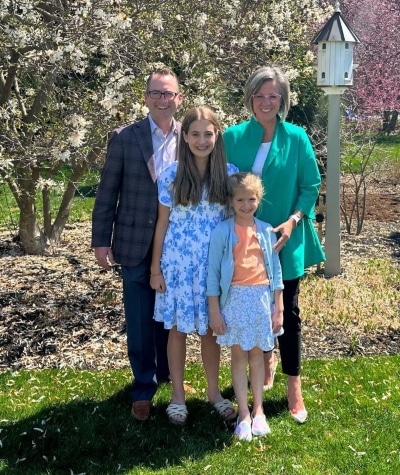
After our daughters were born, we went on to welcome a full-term baby, Martha Rose. She’ll be 8 this summer. We also had a son, William, in 2018. He was diagnosed with trisomy 18 at 14 weeks gestation. I carried him until 34 weeks. He was with us for about 91 minutes before he passed.
Our two living children keep us very busy at home. Lots of family fun – we always hang out with family and friends. We have many sports for our little one, and our older one loves music, voice, and theater.
Do you read much, Martha?
I’m trying to get back into it. One of the best books I’ve ever read – and I think I’m going to read it again because it’s been a few years – is called The Gratitude Diaries by Janice Kaplan. It’s given us a new perspective.
Martha, what’s something big you’ve changed your mind about over the last five or six years?
I’m still working on it, but as my husband would say, I’m very structured and a rule follower. But that structured life ended abruptly when the girls were born. I had to step back a minute and say, “I can’t be in charge of what this future will look like, and I have to keep taking it one day at a time.” The NICU experience really helped me in that way.
COVID had a big impact on me, too – having to adjust quickly because someone was sick or something wasn’t going to work. I have become a slightly more relaxed person.
It’s a crazy world – what keeps you hopeful and optimistic?
I had an interview for our Today is a Good Day podcast. It has one of the favorite lines I’ve ever heard from a dear friend of mine and an incredible nurse, Anne Coyle She leads the bereavement program at Virtua Hospital in New Jersey.
We talk a lot about hope. But Anne told me in the interview, “You always have to keep hope, and hope has to evolve and change.” Going through sickness and uncertain times – you always have hope for the best outcome. Still, when that outcome might not be what you thought it would be, your hope continues to evolve and change.
It hit home for me when I was pregnant with our son William. We had found out so early on that he had trisomy 18, and often, babies with that chromosome abnormality don’t make it to live birth. So I thought he might pass away in utero, but as time went on, and as we shared with Claire and Martha Rose that I was pregnant, we got to a point where we really hoped we would have some time with him, so the girls could meet him. That’s where the hope evolving and changing can sometimes have a beautiful ending.
Finally, Martha, what’s the best advice you ever received?
I have two. One is something Paul and I realized over the past 12 and a half years, and that is being there for people in the small moments of life. Everyone’s there in the big moments of joy, sorrow, death, and sickness. Remembering to be there for loved ones and friends in the small moments is a bigger challenge but almost more important. I have a friend who sent a card every single November for nine years after Mary passed away. Those small moments mean the world.
The other piece of advice I always quote is from my grandmother, Martha Gladys. I loved her to pieces. She never got too worked up about anything and always said, “Nothing stays the same.” That phrase can help you step back a minute and be in the moment. That simple statement is a reminder that life keeps moving forward and all will be OK.
Connect With Your Community
Subscribe to stay informed!
"*" indicates required fields










































![95000-1023_ACJ_BannerAd[1]](https://vista.today/wp-content/uploads/2023/03/95000-1023_ACJ_BannerAd1.jpg)


